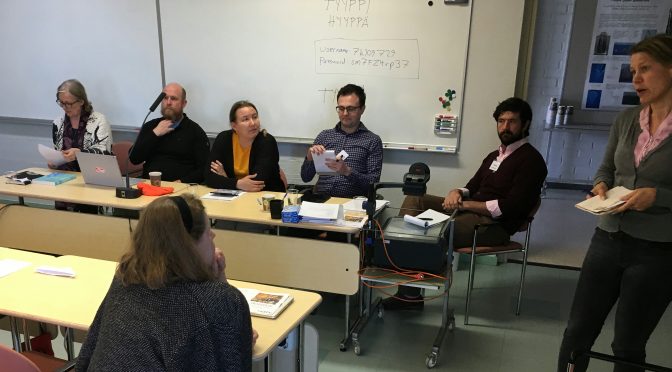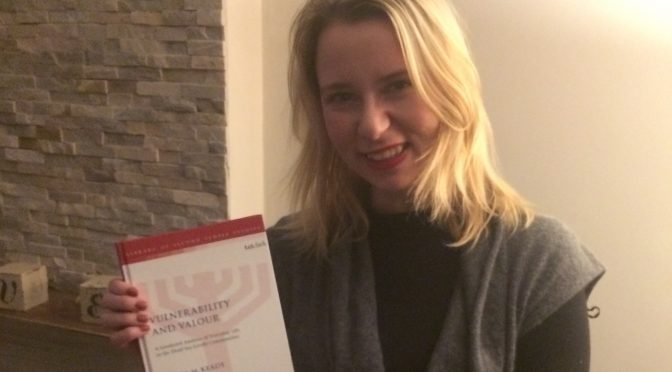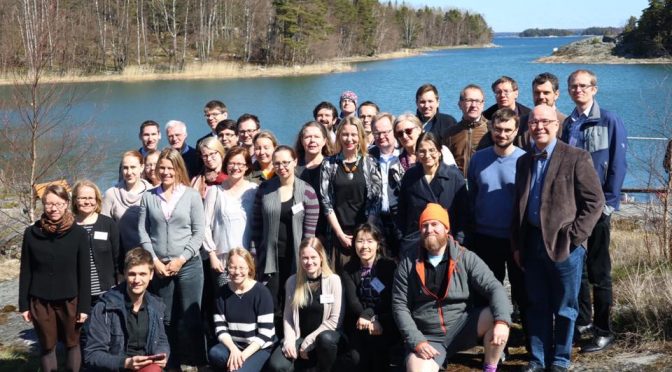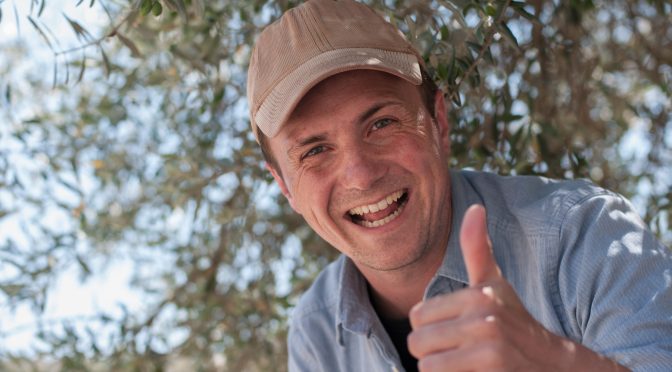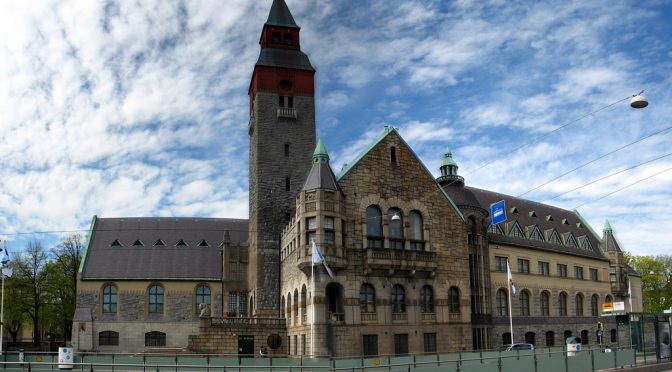What in the world does gender have to do with the historical critical method? Because I write in as the representative of the CSTT’s Team 3 in this forum, I’m expected to somehow connect a discussion of gender with “Literary Criticism in Light of Documented Evidence”. This is not exactly an easy task. Gender is usually thought of as a contextual discussion, and even by gender scholars is conceived as a category that has only entered scholarly and popular consciousness in modern and post modern times. Meanwhile Literar–Kritik, or more broadly, the historical critical method, which encompasses much of what the CSTT’s Team 3 does, makes claims to exist outside of a given context. It is concerned only with revealing the history of the text and behind the text. Or, at least that is how it presents itself. And that is precisely the topic of my discussion. Surprise! I’ve taken an opportunity to turn this into a discussion about methodology. Continue reading CSTT and Gender #2: A Gender Theory Critique of the Historical-Critical Method
All posts by Rick Bonnie
CSTT and Gender #1: An Introduction
by Saana Svärd and Hanna Tervanotko
We first got the idea to do something on gender at the 2016 CSTT annual meeting in Saariselkä, where, during the joint sessions, there was some discussion on gender both as an analytical category for research and as a factor in the scholarly community in general. CSTT is a large community and the research topics we operate with resonate only to a certain extent with those of our colleagues. Some of the most fruitful and engaging discussions within the entire group have been those that somehow address philosophy of research and involve everyone. Continue reading CSTT and Gender #1: An Introduction
Vauvoja ja väitöskirjoja
Vuosi 2016 tarjosi huippuyksikössä paitsi tutkimuksen myös perhe-elämän huippukohtia.
Vuonna 2016 huippuyksikön tutkijoiden Katri Antinin, Sanna Saaren ja Miika Tuckerin väitöskirjat jäivät hetkeksi taka-alalle – varsin onnellisista syistä. ”Lapsen saaminen on ollut uskomaton elämys!” kiteyttää Tucker, marraskuussa syntyneen poikavauvan isä. Tuckerin perheen esikoinen on huippuyksikön piirissä viime vuonna syntyneistä vauvoista tuorein. Saaren tytär syntyi maaliskuussa ja Antinin tammikuussa.
Kaikkien kolmen tuoreen vanhemman kokemus on, että lapsen myötä väitöskirjan kirjoittamiseen käytettävä aika on vähentynyt mutta samaan aikaan työskentely on tehostunut. ”Ennen lasta saatoin lukea useamman tunnin kotona töiden jälkeen, mutta nyt se aika kuluu lapsen kanssa ja kotitöiden hoitamisessa”, sanoo Miika Tucker. ”Toisaalta tämä on ainakin jonkin verran patistanut minua käyttämään työaikaani tehokkaammin työpaikalla”, hän pohdiskelee. Myös Katri Antin kokee, että aika on uudessa elämäntilanteessa kortilla. ”Mutta se ei ole ollenkaan huono asia, koska olen mielestäni aikaisempaa keskittyneempi ja tehokkaampi työssäni”, hän toteaa. ”Vaikka keskeneräinen väitöskirja on aina jossain määrin ahdistava asia, nautin nykyään enemmän siitä, että saan istua alas rauhassa ja tehdä jotain keskeytyksettä.”
Katri Antin ja Sanna Saari palasivat kumpikin töihin lapsen ollessa noin vuoden ikäinen. Molemmat ovat hyödyntäneet tutkijan työn mahdollistamia joustoja. Antin ja hänen puolisonsa ovat molemmat osittaisella hoitovapaalla ja työskentelevät vuorotellen. Näin lapsi voi olla vielä kotihoidossa, vaikka molemmat vanhemmat käyvät töissä. Myös Saari ja hänen puolisonsa ovat suunnitelleet työ- ja loma-ajat siten, että lapsi voi olla mahdollisimman pitkään kotona ennen päivähoidon aloittamista. Miika Tuckerin perheessä vanhempainvapaalla on tällä hetkellä Tuckerin puoliso, tutkija hänkin. Lapsen syntymän jälkeen Tucker on ottanut entistä enemmän vastuuta kotitöistä mutta se ei tunnu raskaalta: ”Koen nykyään työpaikalla olemisen hyvänä vaihteluna kotitöihin, joihin kuluu yleensä tunti tai pari aina illalla. Puolisollani ei ole tätä vaihtelun mahdollisuutta samassa määrin mitä minulla, mutta yritän järjestää myös hänelle tilaisuuksia päästä kodin ulkopuolelle harrastamaan”, sanoo Tucker.
Sekä Katri Antin että Sanna Saari korostavat, että vanhempainvapaa toi väitöskirjan tekoon nostetta: ”Motivaatio väitöskirjan tekemiseen kasvoi hurjan paljon kun työ oli vuoden verran taka-alalla. Ehkä sitä alitajuisesti työsti lapsenhoidon lomassa,” pohtii Saari. Miika Tuckerilla ei ole takanaan yhtä pitkää taukoa mutta lapsi toi hänellekin mukanaan uudenlaista kannustetta työhön: ”Lapsen synnyttyä koen, että minulla on suurempi vastuu tukea perhettäni taloudellisesti. Pidän työstäni ja haluan jatkaa tällä alalla, ja se on mahdollista vain, jos hoidan työni mahdollisimman tunnollisesti.”
Työ ja vapaa-aika on kolmikon mielestä nykyisin varsin helppoa erottaa toisistaan: ”Koen, että tutkimuksen tekeminen on minulle lepoa kotona olosta ja kotona olo lasten kanssa on niin kokonaisvaltaista, että työstä tulee levättyä väkisinkin”, sanoo Saari.”On mahdotonta hoitaa taaperoa ja näppäillä tietokonetta samaan aikaan”, kiteyttää puolestaan Antin.
Tutkimustyö on nuorille väitöskirjan tekijöille ehtinyt jo muodostua osaksi omaa identiteettiä. Vanhemmuuden myötä tämä osa minuutta on entistä merkityksellisempi. ”Äidiksi tulemisen myötä tutkijan identiteetistä on tullut eri tavalla tärkeä, sillä tutkimus on elämänalue, joka kuuluu minulle, ja saan toteuttaa tutkijana omia lahjojani ja haaveitani”, toteaa Katri Antin.
Jutun kirjoittajan Hanna Vanosen poika syntyi kesäkuussa 2016.
“Vulnerability and Valour: A Gendered Analysis of Everyday Life in the Dead Sea Scrolls Communities” (Bloomsbury T&T Clark, 2017)
Jessica M. Keady (2017) Vulnerability and Valour: A Gendered Analysis of Everyday Life in the Dead Sea Scrolls Communities. Library of Second Temple Studies 91. London/New York: Bloomsbury T&T Clark.
 Jessica M. Keady uses insights from social science and gender theory to shed light on the Dead Sea Scrolls and the Qumran communities. Through her analysis, Keady shows that it was not only women who could be viewed as an impure problem, but also that men shared these characteristics as well.
Jessica M. Keady uses insights from social science and gender theory to shed light on the Dead Sea Scrolls and the Qumran communities. Through her analysis, Keady shows that it was not only women who could be viewed as an impure problem, but also that men shared these characteristics as well.
The first framework adopted by Keady is masculinity studies, specifically Raewyn Connell’s hegemonic masculinities, which Keady applies to the Rule of the Community (in its 1QS form) and the War Scroll (in its 1QM form), to demonstrate the vulnerable and uncontrollable aspects of ordinary male impurities. Secondly, the embodied and empowered aspects of impure women are revealed through an application of embodiment theories to selected passages from 4QD (4Q266 and 4Q272) and 4QTohorot A (4Q274). Thirdly, sociological insights from Susie Scott’s understanding of the everyday – through the mundane, the routing and the breaking of rules – reveal how impurity disrupts the constructions of daily life. Keady applies Scott’s three conceptual features for understanding the everyday to the Temple Scroll (11QTa) and the Rule of the Congregation (1QSa) to demonstrate the changing dynamics between ordinary impurity males and impure females.
Underling each of these three points is the premise that gender and purity in the Dead Sea Scrolls communities are performative, dynamic and constantly changing.
To order this book please visit Bloomsbury Publishing.
Reflections on the 2017 CSTT Annual Meeting: Traditions
By Martti Nissinen
The CSTT Annual Meeting of this year took place in the most beautiful environment of the Zoological Station of Tvärminne in Hanko, Finland. The days were sunny, chilly, and full of action. Continue reading Reflections on the 2017 CSTT Annual Meeting: Traditions
New book “Sahidic 1 Samuel – A Daughter Version of the Septuagint 1 Reigns” (V&R, 2017)
 Elina Perttilä (2017) Sahidic 1 Samuel – A Daughter Version of the Septuagint 1 Reigns. De Septuaginta Investigationes 8. Göttingen: Vandenhoeck & Ruprecht.
Elina Perttilä (2017) Sahidic 1 Samuel – A Daughter Version of the Septuagint 1 Reigns. De Septuaginta Investigationes 8. Göttingen: Vandenhoeck & Ruprecht.
Elina Perttilä’s study considers the Sahidic version of 1 Samuel as a translation and how it may best be used in Greek textual criticism. The first aim is to examine the translation technique of the Sahidic translator. The second aim is to analyze the affiliations between the Sahidic manuscripts and the affiliations between the Sahidic version and Greek traditions. This translation-technical study will allow a more careful and accurate citation of the Sahidic version within the critical apparatus of the Greek text.
For more information and to order the book, please visit Vandenhoeck & Ruprecht.
Materialising Jewish rituals: an Interview with Rick Bonnie
What is your research about, in general terms?
For my research, I currently examine the impact of ‘materials’ in the development and shaping of Jewish religious rituals during what’s been termed the Late Second Temple period in the region of modern Israel/Palestine, that is, roughly the first century BCE and CE. In particular, I research two material features that were introduced into the region during this period: monumental, stand-alone synagogue buildings used for communal gatherings and domestic stepped pools used for purification rituals. Both aspects were used among Jews already before the first of these manmade structures was built. So, why were these structures introduced and so well spread out across Jewish society during the first century BCE and CE? This is a question that has received rather little attention in scholarship, where the idea often still lingers that a material change has little influence on the institution of synagogues and purity rituals. Societies were understood as ‘floating’ outside of the material world – uninfluenced by the material surroundings they themselves created. So my second research question is how then did the material elements of these synagogue buildings and stepped pools shape (or change) the related Jewish religious rituals?
What have I found out so far? Well, in my research I have emphasized, for example, the irregularity of water in these manmade pools, as during the long, dry summers in the region primary water needs (drinking, washing etc.) would come first. This raises the question if people would have shared these pools during such occasions, or whether the tradition of water purification was perhaps altered during such extreme periods, perhaps by simply pouring a smaller amount of ‘pure’ water over one’s body. I’ve also focused on how the standing water in these stepped pools would become dirty and unhealthy over time. With regard to the stand-alone synagogues, the main observation I have made so far is that they were not as ‘public’ as previously assumed. They are nothing like the later synagogues, built during the third to sixth centuries (or our current churches), with their large, grotesque doors (sometimes more than one) and monumental façades inviting the congregation to gather. Instead, the façade of these early synagogues was usually rather unimpressive and, due to a lack of decoration, would have blended in with the larger village surroundings in which it stood. Its door (usually not more than one) was more narrow and usually did not provide a direct line of sight into the main congregation hall of the synagogue. These observations fit well with earlier research that showed that only a rather small percentage (ca. 10-20%) of a town’s population would fit in these buildings. This evidence hints toward a split community to some degree: those who made the decisions and discussing town politics, and those who did not. There appears thus to have been a more significant social segregation in these communities than there was later on, when all people were invited to participate in the congregation.
Why particularly did you choose this topic?
I first came to this topic through my doctoral research at the University of Leuven, in Belgium. There I focused on the socio-cultural development of Galilee in the second century CE. To study this development, I also needed to contrast the period in question with what came before, so the first centuries BCE and CE. Doing so, I felt a kind of unease with the broad claims that were made in some studies about certain ‘traditional’ material elements used by Jews, such as stepped pools and synagogues. In many cases, it felt that these claims were more based on their particular understanding of the texts than on the actual archaeological remains. Why was no one bothered by the fact that the distribution of the archaeological phenomena is so uneven at times. To give one example, we have various homes in Sepphoris with more than one stepped pool, while in others none were found. Clearly there is something going on here in terms of economic, social, cultural, or religious differentiation between these homes which we cannot really put our finger yet on.
How would you describe the relevance of your work for society?
I have been struggling with this question for as long as I’ve been doing archaeology. Surely there is a certain societal relevance to my work, but it is not as straightforward and as easy to pin down as, for instance, medical research with the potential of saving babies’ lives. Yet, often it gets forgotten that in those fields, the role of the individual researcher is rather minor – only a small block in a long chain of research toward the actual societal result. The individuality of humanities research often makes the public—and even the researchers themselves—forget about their longer research chain and its societal results (and, thus, relevance). It is this, I think, that has led to the more recent criticism levelled against humanities research—the larger picture and relevance often gets lost. This is why being part of the CSTT is such a great experience—you feel the larger relevance of the centre, as well as that of your own research.
My archaeological research will not be of direct, physical relevance to the person on the street. However, the material emphasis in my study shifts the balance toward the everyday aspects not usually given attention in history books or textual sources, yet which of course played important roles in the community at that time and, as a result, was of significant influence to society. Moreover, archaeology’s concern with ‘context’ provides an opportunity to balance people’s black-and-white views on ancient as well as recent events. The strong partition in society that has grown so clearly over the last decade (producing extremists, nationalists, etc.) is often due to a lack of understanding of contextual information. In our globalized world with more information coming toward us than ever before, clarifying context is crucial.
Which archaeological find, of all those you’ve been a part of, was most exciting to you? Why?
I must confess, and this may sound odd, that I don’t have a particular find that has excited me the most. To be sure, last year’s mosaic floor at Horvat Kur was a very nice find. It hits a certain emotional level, as the inscription on it mentions the first known name of a person (Yudan bar Susu) to possibly have lived in this village in antiquity. It brings you closer to the actual people who lived here. Even the name of our site, ‘Horvat Kur’, is a modern one and we have no idea how the place was called in antiquity. But I cannot say that this personally was my most exciting find. Perhaps this sounds strange, but it is not the finds that excite me so much about archaeology. This is simply a consequence of the particular location where one digs—there’s more luck than skill in finding something spectacular.
Instead, I get more excited about the knowledge one is able to retrieve from a particular find, whatever it may be: a potsherd, a roof tile fragment, or a soil sample. This knowledge is not inherent in the find itself, but derives from the context where it was found. Perhaps the most exciting finds are the roof tile fragments found at Horvat Kur. Roof tiles? That sounds so dull! That may be, but petrographic research by our Horvat Kur team has shown that a considerable number of them were produced in the region of Cilicia, in south-west Turkey. The fact that a normal, small village in rural eastern Galilee used roof tiles made some 1000 km away shows how well-connected the Roman and Byzantine Empires were.
Is there anything you’ve researched that you never thought you’d find yourself interested in?
Well, this question fits my entire career in a way. It was never my plan to focus my research on Jewish and biblical history, let alone be physically working in a Biblical Studies department. It’s mainly my interest in research as such that brought me here, not the particular subjects themselves. I hold a (perhaps too) wide interest in archaeology, ranging from archaeological theory, ethics and the history of archaeology, to cultural heritage management and materials science. A mentor of mine in Leiden University, first enticed my interest in Roman archaeology, the cultural image of ‘Rome’ and its interaction with native subjects. The Roman Empire interests me, in part, because of how the West leans in its values and politics on Rome’s heritage, though I should say on their interpretation of this heritage. For my undergraduate thesis, I chose in 2005/6 one particular region to examine its cultural exchange with ‘Rome’. This became Galilee, in Israel. The initial topic turned out to be a bit larger than I expected… and, yes, I’m still working on it ten years later!
What are you working on at the moment?
Currently, I’m quite excited about plaster… especially the plaster that was used for the stepped pools in order to avoid seepage losses. I am currently planning to do a short field season with colleagues this summer to visit some sites and to analyze the plaster of some stepped pools there. I hope this investigation will show more regarding how it was made, where its natural components originated from, and perhaps if it can tell us something about the water that was held in these pools. Also we’re planning to build some digital 3D models of these pools using photogrammetry. We then can use these digital models for simulating the water level fluctuation in these pools based on paleo-climatic evidence.
Interview conducted by Helen Dixon
“Working With Cultural Objects and Manuscripts: Provenance, Legality, and Responsible Stewardship” (Helsinki, 5-6 June)
The symposium takes place on Monday 5 and Tuesday 6 June 2017 in the premises of the National Museum of Finland, Helsinki.
Programme
Monday, June 5
| 9:30-10:00 | Registration & Coffee |
| 10:00-11:00 | SESSION 1: Welcome & Introduction to the Issues |
| 10:00-10:10 | Elina Anttila (National Museum of Finland) Opening words |
| 10:10-10:30 | Suzie Thomas & Visa Immonen (University of Helsinki) “Working with Cultural Objects and Manuscripts in a Finnish Context: Reflections on Issues and Possibilities” |
| 10:30-11:00 | Jussi Nuorteva (National Archives of Finland; Finnish National Commission for UNESCO; UNESCO International Advisory Committee for the Memory of the World Programme) “UNESCO Memory of the World Programme and Measures to Safeguard Documentary Heritage” |
| 11:00-13:00 | Lunch |
| 13:00-15:30 | SESSION 2: Museums |
| 13:00-14:00 | Keynote Speaker: Magnus Olofsson (Swedish National Heritage Board; Vasa Museum; ICOM Nord) “Cooperation, ethics and the need for new legislation – Some examples of how Sweden works to prevent cultural heritage crime” |
| 14:00-14:30 | Anni Guttorm (Siida Museum, Inari) “Homecoming: Experiences of Sámi Object Repatriations at the Sámi Museum Siida” |
| 14:30-15:00 | Susanna Pettersson (Ateneum National Gallery) “Acquiring fine arts: trade, ownership and provenance” |
| 15:00-15:30 | Nida Dandashi (University of Helsinki) “The Archaeological Museum of Homs and its Collection: Past and Present” |
| 15:30-16:00 | Coffee Break |
| 16:00-18:30 | SESSION 3: Academia |
| 16:00-17:00 | Keynote Speaker: Christopher Rollston (George Washington University) “Flotsam and Jetsam: Salvage Work in a Sea of Forged and Pillaged Inscriptions“ |
| 17:00-17:30 | Damien Huffer (Stockholm University) “Bodies in the Lab, Skulls on the Mantlepiece: Studying Human Remains in Academia, from Online Markets to Teaching Collections” |
| 17:30-18:00 | Åke Engsheden (Stockholm University) “Bits and Pieces from Monastic Life in Late Antique Egypt: Coptic Ostraca in Museum Gustavianum, Uppsala” |
| 18:00-18:30 | Sanna Aro-Valjus (University of Helsinki) “The Allure of Touch, the Desire to Possess: Finnish Assyriologists and Cuneiform Tablets“ |
| 19:30-21:30 | Speakers’ dinner |
Tuesday, June 6
| 9:00-9:30 | Coffee |
| 9:30-11:30 | SESSION 4: Government |
| 9:30-10:30 | Keynote Speaker: Patty Gerstenblith (DePaul University) “Looting of Archaeological Sites amid Armed Conflict: Government and Legal Responses” |
| 10:30-11:00 | Raila Kataja (National Board of Antiquities; National Museum of Finland) “The Reality of Exporting Cultural Goods: The Point of Views of the Licensing Authority” |
| 11:00-11:30 | Josephine Munch Rasmussen (Norwegian Institute of Cultural Heritage Research) “Illicit trade in Cultural objects and manuscripts: stakeholder responses” |
| 11:30-12:00 | Eero Ehanti (National Museum of Finland; ICOM Finland) “Privileges and Responsibilities: Views on Museum Ethics” |
| 12:00-14:00 | Lunch |
| 14:00-17:00 | SESSION 5: A Way Forward for Finland and the World (roundtable discussion) |
| 14:00-15:00 | Keynote Speaker: Neil Brodie (University of Oxford) “Unprovenanced Objects in the Twenty-First Century: Policies and Problems” |
| 15:00-15:45 | Open discussion |
| 15:45-16:15 | Coffee break |
| 16:15-17:00 | Open discussion |
| 17:00-18:00 | Reception at National Museum of Finland (hosted by the City of Helsinki) |
Famous top scholars in the Soisalon-Soininen symposium
More information on programme and registration for the conference can be found here.
Professor Ilmari Soisalon-Soininen (1917–2002) is best known for his research on the syntax of the Septuagint, the ancient Greek translation of the Hebrew Bible. One of the distinct traits of the Septuagint is its nature as a translation from a Semitic language to an Indo-European one. Actually, many of the books included in the Septuagint have different translations whose style and degree of literalism vary greatly. The translators can be characterized by their choice of renderings in such Hebrew structures that can be rendered in many different ways in different contexts. Some of the translators of the Septuagint aimed at rendering a certain Hebrew grammatical structure by a fixed Greek structure as often as possible, sometimes producing unidiomatic Greek or an obscure meaning. Thus the syntax of the translation is partly governed by the source language. Soisalon-Soininen did pioneering work in taking this aspect fully into account by his translation-technical methodology. Continue reading Famous top scholars in the Soisalon-Soininen symposium
New book “Insights into Editing in the Hebrew Bible and the Ancient Near East” (Peeters, 2017)
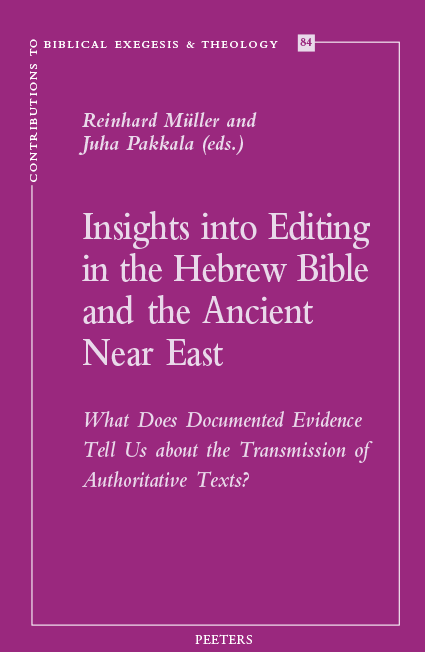 Reinhard Müller and Juha Pakkala, eds (2017) Insights into Editing in the Hebrew Bible and the Ancient Near East. What Does the Documented Evidence Tell Us about the Transmission of Authoritative Texts? Contributions to Biblical Exegesis & Theology 84. Leuven: Peeters.
Reinhard Müller and Juha Pakkala, eds (2017) Insights into Editing in the Hebrew Bible and the Ancient Near East. What Does the Documented Evidence Tell Us about the Transmission of Authoritative Texts? Contributions to Biblical Exegesis & Theology 84. Leuven: Peeters.
Documented evidence has shown that the Hebrew Bible was edited by successive scribes for centuries, and the impact of editing on the resulting text has proven to be crucial. A better understanding of any issue in the Hebrew Bible and ancient Israel requires a deep understanding of the editorial processes. As a consequence, the editorial processes of the Hebrew Bible have come to the fore in the most recent scholarly debates.
Nevertheless, editorial processes in the Hebrew Bible are still poorly understood and a methodological overview is lacking. It is apparent that collaboration between scholars of different fields is needed, and a methodological discussion that takes into account all the editorial techniques witnessed by documented evidence in the Hebrew scriptures and the rest of the ancient Near East is required. This book is a step in this direction. Contributions in this volume by leading scholars approach the issue from various perspectives, including methodology, textual criticism, redaction criticism, Dead Sea Scrolls, Assyriology, and Egyptology.
For more information and to order the book, please visit Peeters Publishers.


